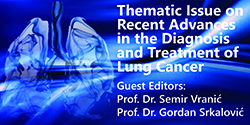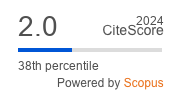Reliability of transthoracic and transesophageal echocardiography in predicting the size of atrial septal defect
Keywords:
Interatrial septal defect, Echocardiography, Streched ballon diameter, Amplatzer septal occluderAbstract
Objective. To determine the reliability of transthoracic echocardiography(TTE) and transesophageal echocardiography (TEE) in predictingthe size of an atrial septal defect (ASD). Material and methods.The study included 16 patients who underwent the catheter-basedprocedures to close an atrial septal defect between February 2008 andDecember 2011 at the Paediatrics Clinic, CCU Sarajevo, after clinicaland TTE and TEE evaluation. In order to determine the assumed diameterof the balloon (A-SBD), we used the formula of quantificationA-SBD=TTE defect diameter×1:09 + 3.9 mm and A-SBD=1.1× transesophagealdiameter of ASD+2.0 mm. The ASD was examined usingthe long-axis view, the basal short-axis view, the apical four-chamberview and the subcostal view to observe its position, diameter and relationto neighbouring structures. The largest diameter was selectedas the reference diameter. Results. Of the total number of treatedpatients, 11 were female. Treatment was conducted by a foreign andlocal team of invasive cardiologists. The average age of the patientswas 8.43 years (2 -17 years). Apart from a transient disturbance ofrhythm in the youngest patients, there were no other intra and postproceduralcomplications. The obtained formulas represent “our” defaultsize of the SBD, based on measurements of TTE and TEE: A-SBD(TTE)=6.02+0.86×TTE and A-SBD (TEE)=3.93+0.86×TEE. Conclusion.ASD diameter determined by TTE and TEE can reliably determinethe appropriate size needed Amplatzer Septal Occluder device.References
Dickenson DE, Arnold R, Wilkinson JL. Congenital heart disease among 160 480 liveborn in Liverpool 1960-1969. Implication for surgical treatment. Br Heart J. 1981;46:55-62.
Kirklin JW, Barratt-Boyces BG. Cardiac surgery. 2nd ed. New York: Churchill Livingstone; 1993. p. 609-44.
Galal MO, Wobst A, Halees Z, Hatle L, Schmaltz AA, Khougeer F, et al. Perioperative complications following surgical closure of atrial septal defect type II in 232 patients: a baseline study. Eur Heart J. 1994;15:1381-4.
Du ZD, Hijazi ZM, Kleinman CS, Silverman NH, Larntz K. Comparison between transcatheter and surgical closure of secundum atrial septal defect in children and adults: results of a multicenter nonrandomized trial. J Am Coll Cardiol. 2002;39:1836-44.
Masura J, Gavora P, Podnar T. Long-term outcome of transcatheter secundum-type atrial septal defect closure using Amplatzer septal occluders. J Am Coll Cardiol. 2005;45:505-7.
Yew G, Wilson NJ. Transcatheter atrial septal defect closure with the Amplatzer septal occluder: five-year follow-up. Catheter Cardiovasc Interv. 2005;64:193-6.
Faletra F, Scarpini S, Moreo A, Ciliberto GR, Austoni P, Donatelli F, et al. Color Doppler echocardiographic assessment of atrial septal defect size: correlation with surgical measurement. J Am Soc Echocardiogr. 1991;4:429-34.
Marx GR, Sherwood MC, Fleishman C, Van Praagh R. Three-dimensional echocardiography of the atrial septum. Echocardiography. 2001;18:433-43.
Lu JH, Hsu TL, Hwang B, Weng ZC. Visualization of secundum atrial septal defect using transthoracic three-dimensional echocardiography in children: implications for transcatheter closure. Echocardiography. 1998;15:651-66.
Acar P, Roux D, Dulac Y, Rouge P, Aggoun Y. Transthoracic three-dimensional echocardiography prior to closure of atrial septal defects in children. Cardiol Young. 2003;13:58-63.
Durongpisitkul K, Tang NL, Soongswang J, Laohaprasitiporn D, Nana A, Kangkagate C. Cardiac magnetic resonance imaging of atrial septal defect for transcatheter closure. J Med Assoc Thai.
;85(Suppl 2):S658-66.
Durongpisitkul K, Tang NL, Soongswang J, Laohaprasitiporn
D, Nanal A. Predictors of successful transcatheter closure of atrial septal defect by cardiac magnetic resonance imaging. Pediatr Cardiol. 2004;25:124-30.
Mazic U, Gavora P, Masura J. The role of transesophageal echocardiography in transcatheter closure of secundum atrial septal defects by the Amplatzer septal occluder. Am Heart J. 2001;142:482-8.
Zhu W, Cao QL, Rhodes J, Hijazi ZM. Measurement of atrial septal defect size: a comparative study between three-dimensional transesophageal echocardiography and the standard balloon sizing methods. Pediatr Cardiol. 2000;21:465-9.
Carcagni A, Presbitero P. New echocardiographic diameter for Amplatzer sizing in adult patients with secundum atrial septal defect: preliminary results. Catheter Cardiovasc Interv. 2004;62:409-14.
Mathewson JW, Bichell D, Rothman A, Ing FF. Absent posteroinferior and anterosuperior atrial septal defect rims: factors affecting nonsurgical closure of large secundum defects using the Amplatzer occluder. J Am Soc Echocardiogr. 2004;17:62-9.
Huang CF, Fang CY, Ko SF, Chien SJ, Lin IC, Lin YJ, et al. Transcatheter closure of atrial septal defects with superior–anterior rim deficiency using Amplatzer septal occluder. J Formos Med Assoc. 2007;106:986-91.
Lin SM, Tsai SK, Wang JK, Han YY, Jean WH, Yeh YC. Supplementing transesophageal echocardiography with transthoracic echocardiography for monitoring transcatheter closure of atrial septal defects with attenuated anterior rim: a case series. Anesth Analg. 2003;96(6):1584-8.
Helgason H, Jonsdottir G. Spontaneous closure of atrial septal defects. Pediatr Cardiol. 1999;20:195-9.
Radzik D, Davignon A, Van Doesburg N, Fournier A, Marchand T, Ducharme G. Predictive factors for spontaneous closure of atrial septal defects diagnosed in the first 3 months of life. J Am Coll
Cardiol. 1993;22:851-3.
Durongpisitkul K, Tang NL, Soongswang J, Laohaprasitiporn
D, Nanal A. Predictors of successful transcatheter closure of atrial septal defect bycardiac magnetic resonance imaging. Pediatr Cardiol. 2004;25:124-30.
Mazic U, Gavora P, Masura J. The role of transesophageal
echocardiography in transcatheter closure of secundum atrial septal defects by the Amplatzer septal occluder. Am Heart J. 2001;142:482-8.
Zhu W, Cao QL, Rhodes J, Hijazi ZM. Measurement of atrial septal defect size: a comparative study between three-dimensional transesophageal echocardiography and the standard balloon sizing methods. Pediatr Cardiol. 2000;21:465-9.
Carcagni A, Presbitero P. New echocardiographic diameter for Amplatzer sizing in adult patients with secundum atrial septal defect: preliminary results. Catheter Cardiovasc Interv. 2004;62:409-14.
Mathewson JW, Bichell D, Rothman A, Ing FF. Absent posteroinferior and anterosuperior atrial septal defect rims: factors affecting nonsurgical closure of large secundum defects using the Amplatzer occluder. J Am Soc Echocardiogr.
;17:62-9.
Huang CF, Fang CY, Ko SF, Chien SJ, Lin IC, Lin YJ, et al. Transcatheter closure of atrial septal defects with superior–anterior rim deficiency using Amplatzer septal occluder. J Formos Med Assoc. 2007;106:986-91.
Lin SM, Tsai SK, Wang JK, Han YY, Jean WH, Yeh YC. Supplementing transesophageal echocardiography with transthoracic echocardiography for monitoring transcatheter closure of atrial septal defects with attenuated anterior rim: a case series. Anesth Analg. 2003;96(6):1584-8.
Helgason H, Jonsdottir G. Spontaneous closure of atrial septal defects. Pediatr Cardiol. 1999;20:195-9.
Radzik D, Davignon A, Van Doesburg N, Fournier A, Marchand T, Ducharme G. Predictive factors for spontaneous closure of atrial septal defects diagnosed in the first 3 months of life. J Am Coll
Cardiol. 1993;22:851-3.
Rastegari M, Redington A, Sullivan ID. Influence of the introduction of Amplatzer device on the interventional closure of defects within the oval fossa in children. Cardiol Young. 2001;11:521-5.
Rao PS, Langhough R, Beekman RH, Lloyd TR, Sideris EB. Echocardiographic estimation of balloon-stretched diameter of secundum atrial septal defect for transcatheter occlusion. Am Heart J. 1992;124:172-5.
Jan SL, Hwang B, Lee PC, Fu YC, Chiu PS, Chi CS. Intracardiac ultrasound assessment of atrial septal defect: comparison with transthoracic echocardiographic, angiocardiographic, and balloon-sizing measurements. Cardiovasc Intervent Radiol.
;24:84-9.
Zhang J. The echo diagnosis and intervention of atrial septal defect. In: Zhang YS, Zhu XY, Zhang J, editors. Congenital heart disease intervention and echo diagnosis progress. Xi’an: World Book Publishing Co. Ltd; 2005. p. 108-14.
Demkow M, Ruzyllo W, Konka M, Kepka C, Kowalski M, Wilczynski J, et al. Transvenous closure of moderate and large secundum atrial septal defects in adults using the Amplatzer septal occluder. Catheter Cardiovasc Interv. 2001;52:188-93.
Durongpisitkul K, Soongswang J, Laohaprasitiporn D, Nana A. Intermediate term follow-up on transcatheter closure of atrial septal defects by Amplatzer septal occluder. J Med Assoc Thai.
;83:1045-53.
Newman MF, Kirchner JL, Phillips-Bute B, Gaver V, Grocott H, Jones RH, et al. Longitudinal assessment of neuro- cognitive after coronary by-pass surgery. N Engl J Med. 2001;344:395-402.
Visconti KJ, Bichell DP, Jonas RA, Newburger JW, Bellinger DC. Developmental outcome after surgical versus interventional closure of secundum atrial septal defect in children. Circulation.
;100(19 Suppl):II145-50.






